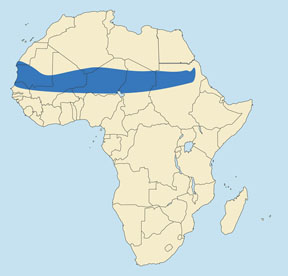 |
Gazella dama
Gacela dama, Gacela mohor (Sp), Damagazelle (G), Gazelle dama (F). Also called addra or mhorr (Arabic).
DESCRIPTION Shoulder height 35-43 inches (89-109 cm). Weight 160-165 pounds (73-75 kg).
A beautiful, very distinctive gazelle. The dama gazelle is the largest of the true gazelles, slender, with a long neck and legs, and short, thick horns. The neck, shoulders and back are chestnut, contrasting sharply with the white rump and underparts. There is a white patch on the throat and a chestnut stripe on the front of the forelegs. No flank band or pygal stripes. The head is pure white in adult males. The short tail is white with a black tip. There is much geographic variation in coloration. The western races (dama, mhorr, lozanoi, permista) are darkest, with the chestnut color covering the entire back and extending down the legs. The eastern dama, or red-necked gazelle (ruficollis) is the lightest, with only the neck and top of the shoulder being chestnut. Central African forms (damergouensis, weidholzi) exhibit gradual variation in color. The extent of chestnut coloration is also affected by season, habitat and age. The horns (both sexes) are short for an animal this size and heavily ringed. They bend well backward at the base, then turn up and a little forward at the tip. Females are similar to males, but have smaller horns and a chestnut forehead.
BEHAVIOR Lives singly or in small groups of 10-15, sometimes in much larger herds during seasonal migrations. Often found with dorcas gazelles. Breeding season varies with the region. A single young is born after 6-1/2 months gestation. Longevity as much as 12 years.
Mainly a browser, sometimes standing on its hind legs to do so, but also feeds on grasses. Drinks water, but can do without it for long periods. Eyesight, hearing and sense of smell are very good.
HABITAT Semi-desert and Sahel savanna.
DISTRIBUTION Remnant populations occur in very low densities on the western and southern edges of the Sahara Desert from Morocco southward to Senegal, then eastward to northwestern Sudan.
TAXONOMIC NOTES Eight subspecies are listed: dama (Senegal to northeastern Nigeria), mhorr (southwestern Morocco), lozanoi (Western Sahara), permista (Senegal and Gambia), reducta (locality unknown), damergouensis (Chad), weidholzi (eastern Mali) and ruficollis (Darfur and Kordofan). We do not separate them.
STATUS All dama gazelles are listed as endangered by the IUCN and are on Appendix I of CITES (1983). The subspecies lozanoi and mhorr are listed as endangered by the USF&WS (1970). The IUCN believes total numbers are in the low thousands and declining, and that if present trends continue it will be only a matter time until the species becomes extinct in the wild. Cannot lawfully be hunted anywhere in its native habitat, but poaching continues. Good numbers are found in captivity in several parts of the world, including Texas game ranches, so the species is not presently in danger of extinction.
|





